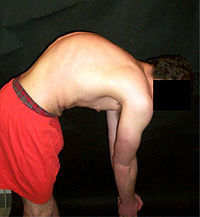
Photo from wikipedia
Purpose To comparatively analyze the clinical and radiographic outcomes of percutaneous kyphoplasty (PKP) in patients with severe osteoporotic vertebral compression fracture (sOVCF) with or without intravertebral cleft (IVC). Methods We… Click to show full abstract
Purpose To comparatively analyze the clinical and radiographic outcomes of percutaneous kyphoplasty (PKP) in patients with severe osteoporotic vertebral compression fracture (sOVCF) with or without intravertebral cleft (IVC). Methods We enrolled a total of 75 patients with sOVCF receiving PKP between January 2016 and December 2018. The patients were divided into the following two groups based on their radiographic findings: with IVC (IVC group) and without IVC (NIVC group). The following radiographic outcomes were determined: anterior vertebral height (AVH), kyphotic angle (KA), lumbar lordosis (LL), sacral slope (SS), pelvic incidence (PI), and pelvic tilt (PT). The clinical functional assessment included Oswestry disability index (ODI) and visual analog scale (VAS) scores. Results No significant difference was found between the demographic data of the two groups (P > 0.05). AVH, KA, and LL in both groups were significantly corrected one month after surgery (P < 0.05). There was statistical difference between the two groups in AVH and KA one year and three years after surgery, and in LL and PT three years after surgery (P < 0.05). Compared with the results one month after surgery, AVH, KA, and LL of the IVC group deteriorated significantly one year and three years after surgery, whereas AVH, KA, and LL of the NIVC group deteriorated significantly three years after surgery (P < 0.05). The VAS and ODI scores in both groups decreased significantly one month, one year, and three years after surgery than preoperative results (P < 0.05), and a statistical difference was observed between the two groups three years after surgery (P < 0.05). Conclusion PKP can give satisfactory outcomes for the treatment of sOVCF with or without IVC. However, the NIVC group showed better clinical outcomes and could maintain spinal sagittal balance better than the IVC group during long-term follow-up.
Journal Title: International Journal of General Medicine
Year Published: 2022
Link to full text (if available)
Share on Social Media: Sign Up to like & get
recommendations!